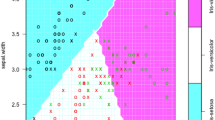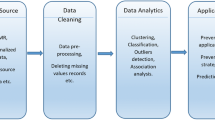Abstract
The trade-off between computation time and predictive accuracy is important in the design and implementation of clinical decision support systems. Machine learning techniques with incremental updates have proven its usefulness in analyzing large collection of medical datasets for diseases diagnosis. This research aims to develop a predictive method for heart disease diagnosis using machine learning techniques. To this end, the proposed method is developed by unsupervised and supervised learning techniques. In particular, this research relies on Principal Component Analysis (PCA), Self-Organizing Map, Fuzzy Support Vector Machine (Fuzzy SVM), and two imputation techniques for missing value imputation. Furthermore, we apply the incremental PCA and FSVM for incremental learning of the data to reduce the computation time of disease prediction. Our data analysis on two real-world datasets, Cleveland and Statlog, showed that the use of incremental Fuzzy SVM can significantly improve the accuracy of heart disease classification. The experimental results further revealed that the method is effective in reducing the computation time of disease diagnosis in relation to the non-incremental learning technique.





Similar content being viewed by others
References
Mendis, S., et al.: Global atlas on cardiovascular disease prevention and control. World Health Organization, Geneva (2011)
Paul, A.K., et al.: Adaptive weighted fuzzy rule-based system for the risk level assessment of heart disease. Appl. Intell. 48(7), 1739–1756 (2018)
McAloon, C.J., et al.: The changing face of cardiovascular disease 2000–2012: an analysis of the world health organisation global health estimates data. Int. J. Cardiol. 224, 256–264 (2016)
Luengo-Fernandez, R., Leal, J., Gray, A.: UK research expenditure on dementia, heart disease, stroke and cancer: are levels of spending related to disease burden? Eur. J. Neurol. 19(1), 149–154 (2012)
El-Bialy, R., et al.: Feature analysis of coronary artery heart disease data sets. Procedia Comput. Sci. 65, 459–468 (2015)
Metwally, A.H., Elgamal, M.-A.F.: The relation between hepatitis C virus and coronary heart disease. Med. Hypotheses 82(4), 505 (2014)
Das, R., Turkoglu, I., Sengur, A.: Effective diagnosis of heart disease through neural networks ensembles. Expert Syst. Appl. 36(4), 7675–7680 (2009)
Gudadhe, M., Wankhade, K., Dongre, S.: Decision support system for heart disease based on support vector machine and artificial neural network. In: 2010 International Conference on Computer and Communication Technology (ICCCT), IEEE (2010)
Berner, E.S.: Clinical decision support systems, vol. 233. Springer, Berlin (2007)
Johnston, M.E., et al.: Effects of computer-based clinical decision support systems on clinician performance and patient outcome: a critical appraisal of research. Ann. Intern. Med. 120(2), 135–142 (1994)
Bhatia, S., Prakash, P., Pillai, G.: SVM based decision support system for heart disease classification with integer-coded genetic algorithm to select critical features. In: Proceedings of the world congress on engineering and computer science (2008)
Mantel, N.: The detection of disease clustering and a generalized regression approach. Cancer Res. 27(2), 209–220 (1967)
Nahato, K.B., Nehemiah, K.H., Kannan, A.: Hybrid approach using fuzzy sets and extreme learning machine for classifying clinical datasets. Inform. Med. Unlocked 2, 1–11 (2016)
Nilashi, M., et al.: A knowledge-based system for breast cancer classification using fuzzy logic method. Telematics Inform. 34(4), 133–144 (2017)
Fida, B., et al.: Heart disease classification ensemble optimization using genetic algorithm. In: 2011 IEEE 14th International Multitopic Conference, IEEE (2011)
Kohonen, T.: Analysis of a simple self-organizing process. Biol. Cybern. 44(2), 135–140 (1982)
Kohonen, T.: Self-organized formation of topologically correct feature maps. Biol. Cybern. 43(1), 59–69 (1982)
Maćkiewicz, A., Ratajczak, W.: Principal components analysis (PCA). Comput. Geosci. 19(3), 303–342 (1993)
Ju, Z., Cao, J.-Z., Gu, H.: Predicting lysine phosphoglycerylation with fuzzy SVM by incorporating k-spaced amino acid pairs into Chou’s general PseAAC. J. Theor. Biol. 397, 145–150 (2016)
Nilashi, M., et al.: A hybrid intelligent system for the prediction of Parkinson’s Disease progression using machine learning techniques. Biocybern. Biomed. Eng. 38(1), 1–15 (2018)
Abdi, H., Williams, L.J.: Principal component analysis. Wiley Interdiscip. Rev. Comput. Stat. 2(4), 433–459 (2010)
Ringnér, M.: What is principal component analysis? Nat. Biotechnol. 26(3), 303 (2008)
Ding, C., He X.: K-means clustering via principal component analysis. In: Proceedings of the twenty-first international conference on Machine learning, ACM (2004)
Wall, M.E., Rechtsteiner, A., Rocha, L.M.: Singular value decomposition and principal component analysis. In: A practical approach to microarray data analysis. 2003, Springer. p. 91–109
Wright, J., et al.: Robust principal component analysis: exact recovery of corrupted low-rank matrices via convex optimization. In: Advances in neural information processing systems (2009)
Übeyli, E.D., Doğdu, E.: Automatic detection of erythemato-squamous diseases using k-means clustering. J. Med. Syst. 34(2), 179–184 (2010)
Adeli, A., Neshat, M.: A fuzzy expert system for heart disease diagnosis. In: Proceedings of International Multi Conference of Engineers and Computer Scientists, Hong Kong (2010)
Nahar, J., et al.: Association rule mining to detect factors which contribute to heart disease in males and females. Expert Syst. Appl. 40(4), 1086–1093 (2013)
Kahramanli, H., Allahverdi, N.: Design of a hybrid system for the diabetes and heart diseases. Expert Syst. Appl. 35(1–2), 82–89 (2008)
Shao, Y.E., Hou, C.-D., Chiu, C.-C.: Hybrid intelligent modeling schemes for heart disease classification. Appl. Soft Comput. 14, 47–52 (2014)
Shilaskar, S., Ghatol, A.: Feature selection for medical diagnosis: evaluation for cardiovascular diseases. Expert Syst. Appl. 40(10), 4146–4153 (2013)
Anooj, P.: Clinical decision support system: risk level prediction of heart disease using weighted fuzzy rules. J. King Saud Univ. Comput. Inform. Sci. 24(1), 27–40 (2012)
Mangiameli, P., Chen, S.K., West, D.: A comparison of SOM neural network and hierarchical clustering methods. Eur. J. Oper. Res. 93(2), 402–417 (1996)
Nilashi, M., et al.: An analytical method for measuring the Parkinson’s disease progression: a case on a Parkinson’s telemonitoring dataset. Measurement 136, 545–557 (2019)
Ahani, A., et al.: Revealing customers’ satisfaction and preferences through online review analysis: the case of Canary Islands hotels. J. Retail. Consum. Serv. 51, 331–343 (2019)
Chen, D.-R., Chang, R.-F., Huang, Y.-L.: Breast cancer diagnosis using self-organizing map for sonography. Ultrasound Med. Biol. 26(3), 405–411 (2000)
Kiviluoto, K.: Predicting bankruptcies with the self-organizing map. Neurocomputing 21(1–3), 191–201 (1998)
Vesanto, J., Alhoniemi, E.: Clustering of the self-organizing map. IEEE Trans. Neural Networks 11(3), 586–600 (2000)
Brown, M.P., et al.: Knowledge-based analysis of microarray gene expression data by using support vector machines. Proc. Natl. Acad. Sci. 97(1), 262–267 (2000)
Joachims, T.: Text categorization with support vector machines: Learning with many relevant features. In: European conference on machine learning, Springer (1998)
Joachims, T.: Learning to classify text using support vector machines, vol. 668. Springer, Berlin (2002)
Guyon, I., et al.: Gene selection for cancer classification using support vector machines. Mach. Learn. 46(1–3), 389–422 (2002)
Orru, G., et al.: Using support vector machine to identify imaging biomarkers of neurological and psychiatric disease: a critical review. Neurosci. Biobehav. Rev. 36(4), 1140–1152 (2012)
Samanta, B., Al-Balushi, K., Al-Araimi, S.: Artificial neural networks and support vector machines with genetic algorithm for bearing fault detection. Eng. Appl. Artif. Intell. 16(7–8), 657–665 (2003)
Gunn, S.R.: Support vector machines for classification and regression. ISIS Tech. Rep. 14(1), 5–16 (1998)
Keerthi, S.S., Lin, C.-J.: Asymptotic behaviors of support vector machines with Gaussian kernel. Neural Comput. 15(7), 1667–1689 (2003)
Schuldt, C., Laptev, I., Caputo, B.: Recognizing human actions: a local SVM approach. In: Proceedings of the 17th International Conference on Pattern Recognition, 2004. ICPR 2004, IEEE (2004)
Mardani, A., et al.: Application of decision making and fuzzy sets theory to evaluate the healthcare and medical problems: a review of three decades of research with recent developments. Expert Syst. Appl. 137, 202–231 (2019)
Nilashi, M., et al.: Factors influencing medical tourism adoption in Malaysia: a DEMATEL-Fuzzy TOPSIS approach. Comput. Ind. Eng. 137, 106005 (2019)
Nilashi, M., et al.: Measuring sustainability through ecological sustainability and human sustainability: a machine learning approach. J. Clean. Prod. 240, 118162 (2019)
Yadegaridehkordi, E., et al.: The impact of big data on firm performance in hotel industry. Electron. Commer. Res. Appl. 40, 100921 (2019)
Lin, C.-F., Wang, S.-D.: Fuzzy support vector machines. IEEE Trans. Neural Netw. 13(2), 464–471 (2002)
Wang, W., Men, C., Lu, W.: Online prediction model based on support vector machine. Neurocomputing 71(4–6), 550–558 (2008)
Zhang, Z., Shen, H.: Application of online-training SVMs for real-time intrusion detection with different considerations. Comput. Commun. 28(12), 1428–1442 (2005)
Cauwenberghs, G., Poggio, T.: Incremental and decremental support vector machine learning. In: Advances in neural information processing systems (2001)
Andridge, R.R., Little, R.J.: A review of hot deck imputation for survey non-response. Int. Stat. Rev. 78(1), 40–64 (2010)
Myers, T.A.: Goodbye, listwise deletion: presenting hot deck imputation as an easy and effective tool for handling missing data. Commun. Methods Meas. 5(4), 297–310 (2011)
Sim, J., Lee, J.S., Kwon, O.: Missing values and optimal selection of an imputation method and classification algorithm to improve the accuracy of ubiquitous computing applications. Math. Probl. Eng. (2015). https://doi.org/10.1155/2015/538613
Nahato, K.B., Harichandran, K.N., Arputharaj, K.: Knowledge mining from clinical datasets using rough sets and backpropagation neural network. Comput. Math. Methods Med. (2015). https://doi.org/10.1155/2015/460189
Nilashi, M., Ibrahim, O., Ahani, A.: Accuracy improvement for predicting Parkinson’s disease progression. Sci. Rep. 6, 34181 (2016)
Nilashi, M., et al.: A soft computing method for mesothelioma disease classification. J. Soft Comput. Decis. Support Syst. 4(1), 16–18 (2017)
Nilashi, M., et al.: An analytical method for diseases prediction using machine learning techniques. Comput. Chem. Eng. 106, 212–223 (2017)
Nilashi, M., et al.: Accuracy improvement for diabetes disease classification: a case on a public medical dataset. Fuzzy Inform. Eng. 9(3), 345–357 (2017)
Ahmadi, N., et al.: An intelligent method for iris recognition using supervised machine learning techniques. Opt. Laser Technol. 120, 105701 (2019)
Santhanam, T., Padmavathi, M.: Application of K-means and genetic algorithms for dimension reduction by integrating SVM for diabetes diagnosis. Procedia Comput. Sci. 47, 76–83 (2015)
Zheng, B., Yoon, S.W., Lam, S.S.: Breast cancer diagnosis based on feature extraction using a hybrid of K-means and support vector machine algorithms. Expert Syst. Appl. 41(4), 1476–1482 (2014)
Hariharan, M., Polat, K., Sindhu, R.: A new hybrid intelligent system for accurate detection of Parkinson’s disease. Comput. Methods Programs Biomed. 113(3), 904–913 (2014)
Ortiz, A., et al.: LVQ-SVM based CAD tool applied to structural MRI for the diagnosis of the Alzheimer’s disease. Pattern Recogn. Lett. 34(14), 1725–1733 (2013)
Toro, C., et al.: Supervoxels-based histon as a new alzheimer’s disease imaging biomarker. Sensors 18(6), 1752 (2018)
Ahmed, H., et al.: Heart disease identification from patients’ social posts, machine learning solution on Spark. Future Gener. Comput. Syst. (2019). https://doi.org/10.1016/j.future.2019.09.056
Pumo, D., et al.: Sensitivity of extreme rainfall to temperature in semi-arid Mediterranean regions. Atmos. Res. 225, 30–44 (2019)
Lee, J.-H., et al.: Modeling landslide susceptibility in data-scarce environments using optimized data mining and statistical methods. Geomorphology 303, 284–298 (2018)
Aguilera, A.M., Escabias, M., Valderrama, M.J.: Using principal components for estimating logistic regression with high-dimensional multicollinear data. Comput. Stat. Data Anal. 50(8), 1905–1924 (2006)
Kim, M.-J., Kim, H.-B., Kang, D.-K.: Optimizing SVM ensembles using genetic algorithms in bankruptcy prediction. J. Inform. Commun. Converg. Eng. 8(4), 370–376 (2010)
Ramezani, M., Karimian, A., Moallem, P.: Automatic detection of malignant melanoma using macroscopic images. J. Med. Signals Sensors 4(4), 281 (2014)
Cattell, R.B.: The scree test for the number of factors. Multivar. Behav. Res. 1(2), 245–276 (1966)
Acknowledgements
This research was funded by the Deanship of Scientific Research at Princess Nourah bint Abdulrahman University through the Fast-track Research Funding Program.
Author information
Authors and Affiliations
Corresponding authors
Rights and permissions
About this article
Cite this article
Nilashi, M., Ahmadi, H., Manaf, A.A. et al. Coronary Heart Disease Diagnosis Through Self-Organizing Map and Fuzzy Support Vector Machine with Incremental Updates. Int. J. Fuzzy Syst. 22, 1376–1388 (2020). https://doi.org/10.1007/s40815-020-00828-7
Received:
Revised:
Accepted:
Published:
Issue Date:
DOI: https://doi.org/10.1007/s40815-020-00828-7




